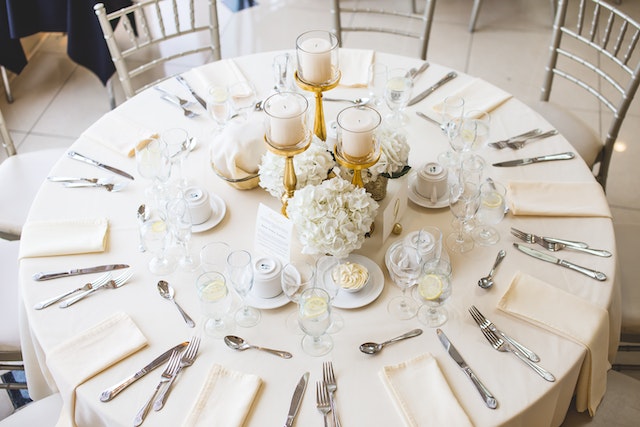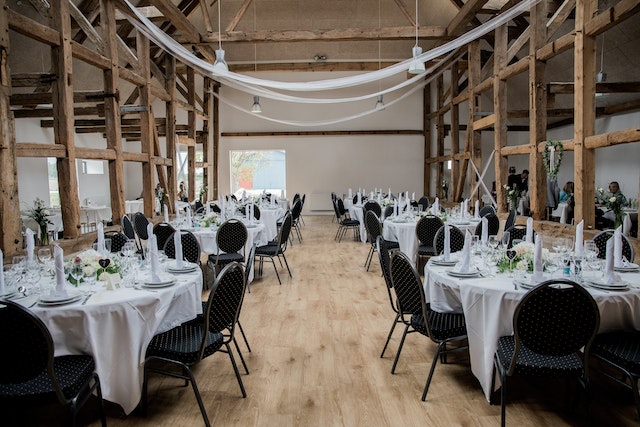In this Article
- Eight Practical Steps For Creating A Wedding Seating Chart
- What table size and shapes are you going to use? Make the proper choice
- Determine the layout of the wedding reception venue
- Plan for the table and seating of the bride and the groom
- Seat the parents accordingly
- Ways to seat the bridal party comfortably
- Group your guests by familiarity or interests
- Be keen when assigning seats and tables
- Use a visual aid through a seating chart tool or app
- How To Display Your Wedding Table Plan and Seat Assignments
- Final Thoughts
There's a lengthy list of things to do when you're planning a wedding. After booking a venue and hiring an excellent photographer, among others, you move on to finalising your guest list.
Next to that is creating your wedding reception seating chart which, at first thought, seems complicated.
It doesn't have to be that. As with most tasks, you're apt to accomplish your wedding table and seating plan easily if you do it at a propitious time. Essentially, you shouldn't leave it to the last minute.
Below are tips, tricks and ideas for creating a successful table and seating chart for your wedding. This article elaborates on 8 practical steps.
Eight Practical Steps For Creating A Wedding Seating Chart

1. What table size and shapes are you going to use? Make the proper choice
Primarily, before planning how to seat your guests, you have to determine the shape and sizes of the tables you are going to use (at the venue). Through this process, you can ascertain how many guests can occupy each table, after which you can work out the grouping.
According to tradition, round tables are usually utilised for wedding receptions. However, rectangular ones are amenable as well, especially as they allow your guests to feel relaxed when they interact.
Make sure that you allocate the right number of seats for every table. You wouldn't want your guests to be squished up in theirs.
Before creating your seating chart, confirm the number of guests that can be seated at a table. A 5-foot diameter round table, for instance, can fit about 8 to 10 guests, while a 5- foot long rectangular one can seat around 6 people.
Other than ensuring the table size, see to it that there is enough space in between so that your attendees can comfortably move around.
2. Determine the layout of the wedding reception venue
You should have booked a venue before devising your wedding seating chart. How is the place set up and how many tables can be arranged in it?
Verify the dance floor area and where the band or the DJ will be situated. The same goes for the buffet or dessert tables and other features of the event.
You must check these factors so that following, you can plan for the seating assignments of your guests.
3. Plan for the table and seating of the bride and the groom
Part of seating all your guests accordingly in the reception venue is to first decide where you, as the couple will sit. As a common option, you can consider a sweetheart table.
It is exclusively occupied by the bride and the groom and is focally situated in the room so that they can have a full view of the guests.
If the couple wants an intimate set up, a sweetheart table is a great choice. Nevertheless, many newlyweds decide on sitting with their family and friends at a single table to share the happiness of the occasion.
Another option is for the bride and groom to sit at the head table along with their family members and the bridal party. Since this set up can get crowded, you can seat other members of the wedding party at a different table.
Based on tradition, the bride sits at the right of the groom. But this is not always the case if the couple opts for something more comfortable.
4. Seat the parents accordingly
The bride and the groom's parents typically sit with each other, including the grandparents and the siblings. Another way is the seat each of them with their familial side. In any way, if either of the above set up crowds the table, it would be smart to split these guests up.
The table that accommodates the parents, family members and close friends should be set up near the sweetheart table. The best ones should be closer to the couple because the day is meant for sharing the joy of the celebration.
Since grandparents ought not to be seated near the speakers or the dance floor (for obvious reasons), it is apt that the sweetheart table isn't, too. Where these are located is a good place to seat the family together.
5. Ways to seat the bridal party comfortably
It can be that you position the bridal party to sit with the couple at the head table. Or else, let them do so in an arrangement that you prefer, such as among themselves at one or two tables or individually with their group of friends.
It makes sense to seat these wedding participants near the dance floor or another prime location.
6. Group your guests by familiarity or interests
You can seat your college friends at a particular table, your workmates at another, or people from your yoga class at one, and so on. Grouping your guests according to qualities and common interests allows them to be comfortable. It will foster good conversations.
Likewise, mix and match your attendees according to their ages or personalities. It's a fantastic opportunity for them to mingle and meet new people.
Seating single friends at a wedding can be tricky. Avoid doing so in one table. You shouldn't play matchmaker at the event.
If you're keen on letting singles mingle, introduce them together during a conversation with your other guests. As a gesture of consideration, don't seat a single friend at a table that's occupied by couples.
As for your parents' friends, ask your folks about where you'll want them to be situated.
If there are kids (10 or more of them), plan on setting up a kids' table where you provide activities to do, such as colouring or playing with small toys. If there aren't too many tots at the party, seat them with their parents.
7. Be keen when assigning seats and tables
You can assign guests by their individual seats, or merely to their tables where they can randomly choose theirs.
These depend on the style of the venue and the food service. Guests with special dietary requirements can be seated at one table.
Designate tables for your attendees around the venue, with the best and primely located ones reserved for your closest family, friends and relatives.
If you're arranging a kids' table, do it near their parents. The latter will need to keep an eye on the former.
8. Use a visual aid through a seating chart tool or app
You'll need a visual aid to guide you in creating your wedding table and seating plan. There are two options for doing this, and one is by scribbling and playing around with it on a giant piece of paper.
You can skip this pernickety and painstaking process by using a digital seating chart tool, app or website. Among the best ones that you can consider are:
- AllSeated
- Wedding Wire
- Style Me Pretty
- Microsoft Office
How To Display Your Wedding Table Plan and Seat Assignments

This has to be done in a creative and eye-catching way, such as by:
Place Cards
These are personalised cards placed on tables where guests can find their names. You can utilise these to perk up your venue and table decor, especially as it matches the theme of the occasion.
This is all too well, but a disadvantage of this method is that guests can be confused as they walk around the tables to look for their seats.
Chart Display
This is a board that's set up at the front of the reception. Guests can refer to this to determine where they will sit. It's either you arrange this guide alphabetically or according to table numbers.
There are heaps of table plan ideas that you can use to complement the theme and style of the event. A major perk of this seating chart assignment is that guests will not only be able to find their seats, but those of the other attendees that they're looking for.
Final Thoughts
Now that you've referred to the article above, you must have realised that creating a wedding reception seating chart isn't that tough at all. Remember that with all your efforts, you can breathe easy knowing that there is your better half, friends and family, and digital and online apps and tools to help you.



